DRAM and Motherboard Makers Demonstrate Quad-Channel DDR4-4000+ Operation
by Anton Shilov on June 9, 2017 2:00 PM EST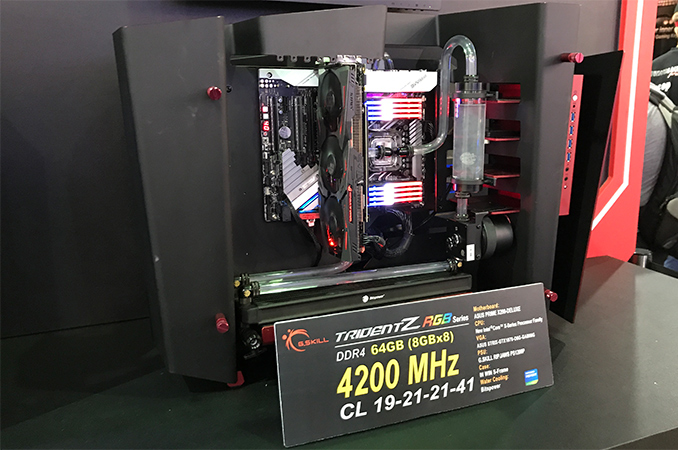
Over the course of Computex, manufacturers of memory modules and motherboards alike took to the show to showcase the latest developments in high-speed quad-channel memory configurations. Powered by Intel’s new Skylake-X CPUs, manufacturers have been able to get quad-channel data transfer rates running at 4000 MT/s and higher. This increased memory bandwidth should, in turn, help Intel’s new Core i7 and i9 processors offer significantly higher performance than predecessors in applications that heavily rely on memory transactions.
Quad-channel memory sub-systems on Intel’s high-end desktop processors have always provided vast amounts of memory bandwidth to multi-core CPUs, even without running DRAM at high data rates. A 256-bit memory sub-system using DDR4-2400 modules has a throughput of 76.8 GB/s. To match it, a 128-bit (dual-channel) memory sub-system would have to use two DDR4-4800 modules. Meanwhile since quad-channel memory by definition provides loads of bandwidth, and due to stability/reliability concerns, Intel opted not to chase high data rates on their first-gen DDR4 controllers found in the Haswell-E and Broadwell-E CPUs, which is why such processors barely supported DDR4-3200+ memory.
With the Skylake CPUs for consumers however, Intel introduced its second-gen DDR4 controller that could handle high data rates and several DRAM module makers quickly rolled out DDR4-4000+ DIMMs for enthusiasts. That controller has evolved with the Kaby Lake generation and ended up in Intel’s Skylake-X processors, enabling Intel’s X299 HEDT platform to support DDR4 modules at well-beyond JEDEC-specified data rates. Fittingly, at Computex, motherboard and memory manufacturers demonstrated how well their high-end X299 platforms and DDR4 DIMMs can work together at high-speeds in quad-channel mode.
Starting things off, G.Skill displayed eight of its Trident Z RGB 8 GB DDR4 modules running in quad-channel mode with a Skylake-X CPU on the ASUS Prime X299 Deluxe at 4200 MT/s with CL19 21-21-41 timings. The CPU was cooled down using a custom liquid cooling system and the PC worked for hours during the show.
The company also showcased its modules running at 4000 MT/s, 4400 MT/s and 4500 MT/s in dual-channel mode on Intel X299-based motherboards from ASRock and GIGABYTE, which is an important news for those planning to use Intel's Kaby Lake-X processors.
Meanwhile GIGABYTE demonstrated its X299 AORUS Gaming 7 running 128 GB of Corsair Vengeance RGB DDR4 memory at DDR4-4133 with CL19 19-19-39 latency settings. The setup was based on the Core i7-7900X (10C/20T) processor operating at 4426 MHz under an LCS, and was running for hours in Gigabyte's air conditioned suite in the Taipei 101.
Corsair itself was a little more conservative than GIGABYTE. In its suite, the company displayed an Intel Core i7-7800X (Skylake-X, 6C/12T) and ASUS Prime X299-Deluxe-based system running 128 GB of its Vengeance RGB memory in quad-channel mode at 3800 MT/s. The CPU was cooled down using Corsair's Hydro H110i AIO LCS, so nothing too extreme.
In addition, the company showcased two of its Vengeance RGB DIMMs running in dual-channel mode at 4600 MT/s on a system featuring Intel's Core i7-7740X (Kaby Lake-X, 4C/8T) and ASUS' ROG Rampage VI Apex motherboard. Again, the CPU used the Hydro H110i AIO LCS and the room temperature was normal.
Last but not least, G.Skill had on the highest frequency kit: a DDR4-4800 dual-channel set of modules, 2x8GB, running at 19-19-19 sub timings. Liquid cooling was applied to the ASRock X299 OC Formula.
Obviously, demonstrations of overclocked systems do not necessarily reflect the formal plans of companies like G.Skill or Corsair when it comes to the Intel X299 platform in general, and for the Intel Skylake X processors in particular.
| Demonstrations of DDR4-4000+ on Intel X299 Platforms at Computex 2017 | ||||||||
| Modules | Motherboard | Channels | Data rate | Latency | Kit Config | |||
| G.Skill Trident Z |
ASRock X299 OC Formula | 2 | 4800 MT/s | CL19-19-19-39 | 16 GB (2x8GB) |
|||
| G.Skill Trident Z RGB |
ASUS Prime X299 Deluxe | 4 | 4200 MT/s | CL19 21-21-41 | 64 GB (8x8GB) |
|||
| ASRock X299 OC Formula | 2 | 4000 MT/s | CL17 18-18-38 | 32 GB (2x16GB) |
||||
| GIGABYTE X299-SOC Champion | 4400 MT/s | CL19 19-19-39 | 16 GB (2x8GB) |
|||||
| ASUS ROG Rampage VI Apex | 4500 MT/s | 16 GB (2x8GB) |
||||||
| Corsair Vengeance RGB |
GIGABYTE X299 AORUS Gaming 7 | 4 | 4133 MT/s | 128 GB (8x16) |
||||
| ASUS Prime X299 Deluxe | 3800 MT/s | |||||||
| ASUS ROG Rampage VI Apex | 2 | 4600 MT/s | CL19 23-23-46 | 16 GB (2x8GB) |
||||
What we do understand today is that the Skylake-X can handle DDR4-4133 and DDR4-4200 speeds in quad-channel mode, whereas the Kaby Lake-X CPUs can go even north from that and hit something like DDR4-4500~4600 in dual-channel mode. In fact, Taiwanese overclocker Toppc has managed to push a single 8 GB G.Skill Trident Z RGB module to 5500 MT/s on MSI’s X299 Gaming Pro Carbon AC (MS-7A95) using Intel’s Core i7-7740K CPU under liquid nitrogen, which proves that DDR4 is gaining overclocking potential as memory controllers get better as well.
Related Reading:
- G.Skill Announces 16 GB DDR4-4333 Memory Kit for Intel Kaby Lake CPUs
- G.Skill Announces Trident Z RGB DDR4 Kits with 16 GB Modules, Up to 128 GB
- Corsair Vengeance RGB DDR4 Memory Modules with LEDs Now on Sale
- Corsair Unveils Vengeance LED Modules: DDR4 Gets Lighting, 4333 MT/s Data-Rate
- Intel Announces Skylake-X: Bringing 18-Core HCC Silicon to Consumers for $1999
- Intel Announces Basin Falls: The New High-End Desktop Platform and X299 Chipset


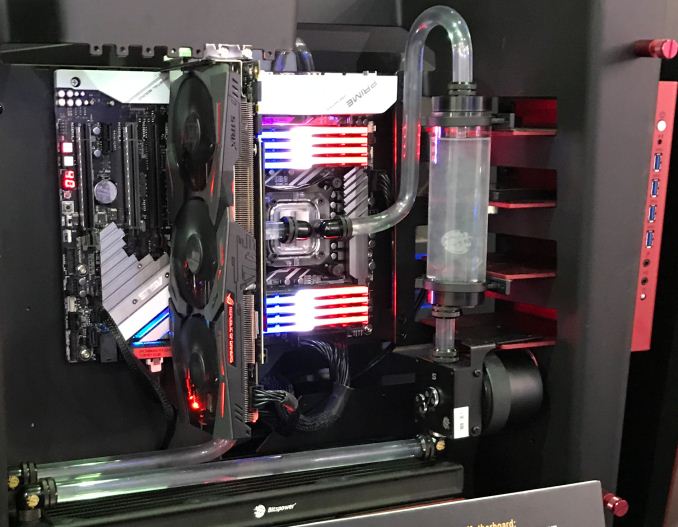
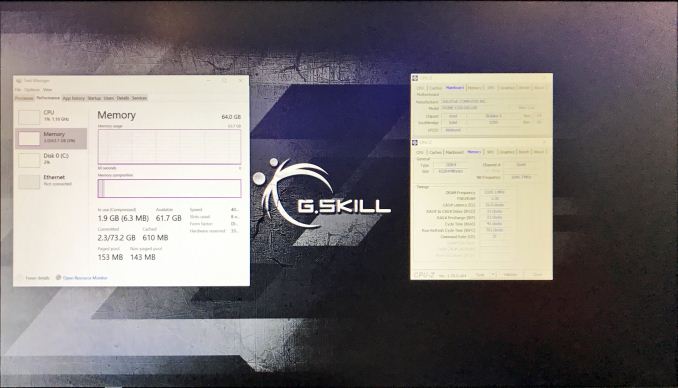
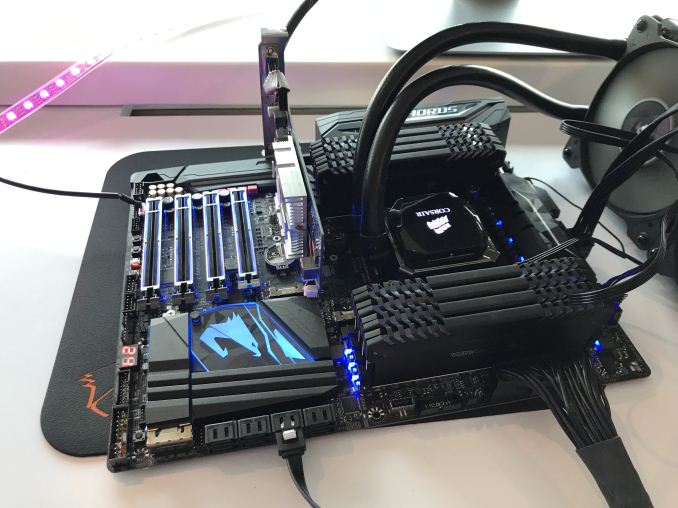
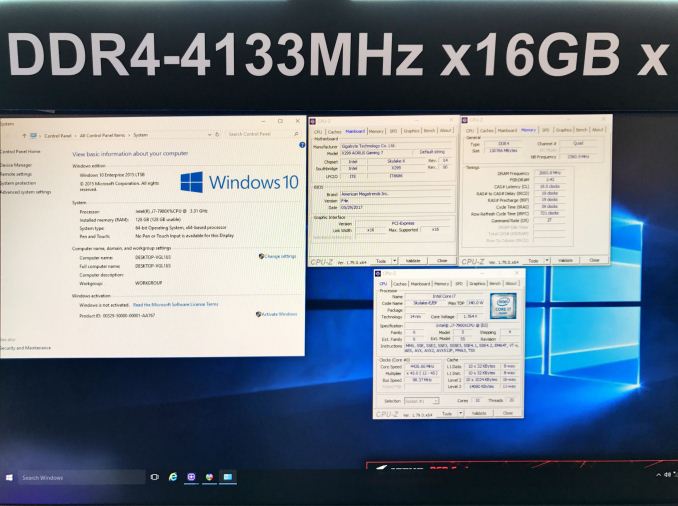

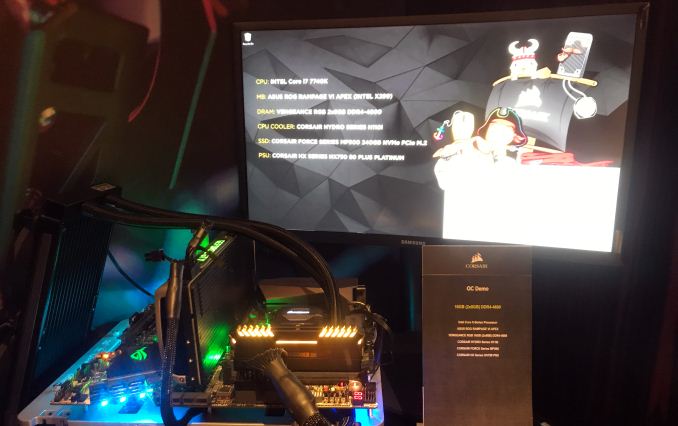
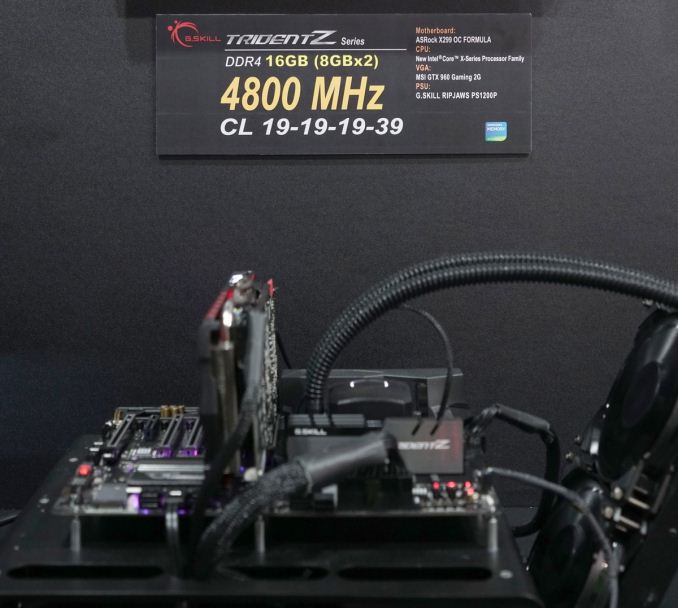








16 Comments
View All Comments
Gothmoth - Friday, June 9, 2017 - link
well if intel would give me more than 28 pci lanes in a 500+ euro CPU i maybe would be interested....JoeyJoJo123 - Friday, June 9, 2017 - link
HOW DARE YOU BADMOUTH INTEL.You're paying for the PRIVILEGE of using 28 lanes. If you want 40 lanes you must deposit addition shekels.
Samus - Friday, June 9, 2017 - link
I'm more curious what 4 channels at 4000MHz even means to raw performance. Historically more than dual channel just hasn't mattered except to very, very specific scenarios where memory subsystem throughout has an effect on the application. X58 demonstrated even triple channel DDR3 1333mhz was overkill (at the time) which is why it was abandoned for years until finally resurfacing in the HEDT market as quad channel, which was also mostly unnecessary (the IPC improvement from Nehalem to Sandy Bridge was pretty mild, something like 9% on average)Either way, it's cool to see, but just entirely unnecessary for 90% of the people who are probably going to adopt it...
Cygni - Friday, June 9, 2017 - link
Knowing what we know about PCI-Ex bandwidth and graphics cards (namely that 16x v 8x doesn't seem to make much if any difference at PCI-Ex 3.0 speeds), as well as the falling utility of Crossfire/SLI in the first place, I don't think it really matters to most gamers. And considering gamers are absolutely the target market for the 7800X and 7820X, it seems like people are making the lanes argument more because they want to whine about something than it being an actual issue for consumers.In an extreme workstation or deep learning environments with 40GbE or Intelliband cards, multiple GPUs, etc... sure! But if you are dropping $500 on NICs and thousands on RAM/GPUs, are you really going to use a 7800X and 7820X?
JoeyJoJo123 - Friday, June 9, 2017 - link
It's more of argument out of principle.All of AMD's HEDT offerings (Threadripper) have identical cache sizes, feature sets, and amount of lanes (64), from lowest end offering to highest end offering. What you pay for is more cores and/or Ghz. That's it. It's a very straightforward approach. So yeah, with the lowest end Threadripper you get 64 lanes, same amount of cache as the 16-core Threadripper flagship, etc.
Intel however fractures their X299 platform (in usual fashion, trying to force users who want a specific feature to have to pay up to a more expensive model) with some being able to do 16 lanes, some do 24 lanes, some do 40+4 lanes. Some have an integrated GPU and can't use it, other have none. Some do dual channel, some do quad channel, some have 4 dimm slots, others have 8 dimm slots. Cache sizes vary wildly from lowest end to highest end.
People are tired of the marketing shenanigans. It's not costing them anything to enable a defacto 40+4 PCI-e lanes across the product stack. Any accusations of cannibalizing their product stack is rendered moot because by charging $500 for a quad-core with 16 PCI-e lanes, you get a lot more from the AMD side.
The complaints of PCI-e lanes aren't because most users will need more than that, but because people aren't wrong to expect the normal 40 PCI-E lanes for HEDT. This is the platform you should be able to assume that "I'm getting more of everything than I really need, so I'm somewhat futureproof.", except with something as minor as 16 PCI-e lanes, it's a joke.
Cygni - Friday, June 9, 2017 - link
I understand people see this as a "morality" issue, that somehow Intel is cheating them by not offering a product they want at the price they want, but quite frankly thats business. Intel is a publicly traded company trying to extract as much money as they can from as many customers as they can, and AMD is doing the exact same thing. AMD thinks offering fully enabled chips will give them a better marketplace edge. They aren't doing it out of the goodness of their hearts. Remember they are the ones that gave us tri-core CPUs made of the exact same fully functional die as more expensive "premium" parts with one core software disabled. And is currently selling a range of chipsets on identical dies with disabled features for the low end.Forced segmentation may not be "consumer friendly", but lets be real... these are big companies chasing big profits, they will be as consumer unfriendly as they can get away with.
naris - Friday, June 9, 2017 - link
Segmentation also helps to sell dies that are partially functional where something is broken in 1 of the cores or whatever..shabby - Friday, June 9, 2017 - link
Unfortunately with competition heating up this segmentation might start hurting them.mickulty - Sunday, June 11, 2017 - link
It's also "business" for people to feel cheated and avoid the crippled product as a result.wumpus - Tuesday, June 13, 2017 - link
The other question is are you not only required to buy a CPU with 40+ PCIe lanes (but less then half of them enabled), do you also have to buy a motherboard with similar capabilities (that is instantly neutered with your neutered CPU? Because the motherboard companies are going to push back even if the consumers don't.